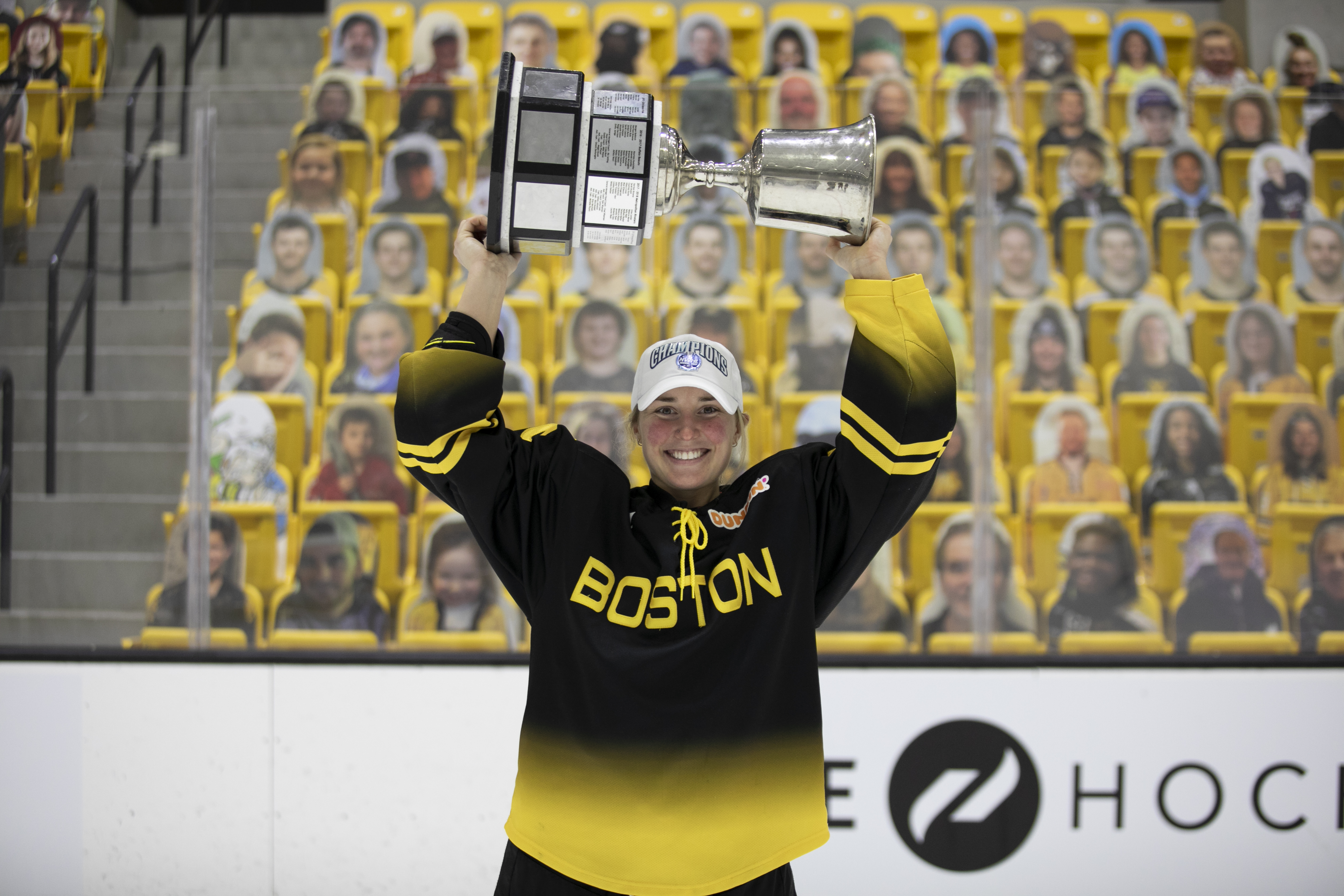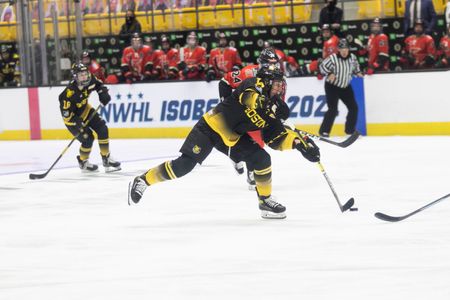Hometown Star

Photos by Michelle Jay
Hometown Star
Professional hockey player Sammy Davis juggles her sport and her studies— all while advocating for the next generation of women athletes
Boston has a long line of professional sports royalty. Rarely, though, do athletes have as strong a connection to the city as hockey star Sammy Davis. Tom Brady was from California, David Ortiz (Hon.’17) from the Dominican Republic, and Bill Russell (Hon.’02) from Louisiana. Davis (CGS’17, Sargent’19, Wheelock’20) grew up in suburban Pembroke, Mass. She played high school hockey at Tabor Academy in Marion, Mass., just like Travis Roy (COM’00, Hon.’16). Then she starred at BU for four seasons. On April 28, 2020, the Boston Pride selected the hometown star with the first overall pick in the National Women’s Hockey League (NWHL) draft—and less than a year later they won the league title.
It’s not just her local roots that differentiate Davis from Boston’s sporting elite. There’s also a mammoth salary gap; even the best women pro athletes can rarely count on their paycheck to make a living. As she competes at the highest level, Davis is also pursuing her doctorate in occupational therapy at the MGH Institute of Health Professions. And she’s advocating for women athletes so future generations won’t have to make the same sacrifices.
Davis and her siblings played a lot of sports growing up—she competed in soccer, field hockey, and softball—but ice hockey quickly became her favorite. “I love the camaraderie and the team atmosphere,” she says. “Knowing that you have 20 friends, 20 people that care about you—it’s a family.” Her father took her to see the Terriers play at Walter Brown Arena—even though he’s a Northeastern alum—and she attended hockey camp at BU. “It was always BU,” she says.

Davis made an immediate impact in her first collegiate season, earning a spot on the Hockey East all-rookie team. By the time she graduated, she was the program’s sixth-highest scorer of all time. And no goal was bigger than the one she scored during overtime of the 2019 Beanpot to beat Harvard and give the Terriers their first title since 1981. Her BU experience extended into the classroom—Davis was a four-time Hockey East All-Academic Team selection.
A misfortune on the ice during a sophomore season practice set her OT career in motion. A flying puck fractured the tip of her pinkie despite the padded hockey glove she wore. After surgery, Davis worked briefly with an occupational therapist. She was already planning to enter Sargent College as a junior, but the experience focused her interest. “I just fell in love with the profession,” she says. She began talking to OTs about their careers and shadowed one who worked with preschoolers.
It was another injury that led her to BU Wheelock. After missing her junior season following double hip surgery, Davis decided to stay at BU for a fifth year to complete her athletic eligibility. That gave her time to earn a master’s in special education, which she hopes will help her if she ends up working in a school setting.
As she neared graduation, Davis knew two things: she wanted to continue studying occupational therapy and she wasn’t ready to walk away from hockey. She considered playing professionally in Europe, but, she says, “I’m a Boston girl through and through.” So, after she was drafted by the Pride, Davis enrolled in the MGH Institute of Health Professions.
Balancing school and hockey necessitates a grueling routine, but Davis makes it work. “Sports have always been such a big part of my life,” she says. “And I’ve found that playing hockey makes me a better person in other areas.” She’s out of bed at 6 am for her daily morning workout in the summer. Then it’s off to class all day, and, finally, Pride practice at about 8:30 pm—a concession to the fact that the women on the team all need to maintain second careers to support themselves. “I get home at 11, go to bed, and then the next day it’s the same thing again,” Davis says.
It’s not exactly a formula for peak athletic performance—and the gender disparities are not lost on Davis. “When I was younger, I used to say, ‘I want to play in the NHL,’” she says. “Now that there is a league that girls can look up to, it’s amazing. But we still have a long way to go. I would love to get to decide to be an OT or a professional athlete. You don’t get to choose right now, because you can’t make a living being a professional athlete.”
Now that there is a league that girls can look up to, it’s amazing. But we still have a long way to go. I would love to get to decide to be an OT or a professional athlete. You don’t get to choose right now, because you can’t make a living being a professional athlete.
Davis is keenly aware of her role as an advocate for women’s sports. “Using our voices and our platform is so important. We keep asking and pushing for more, and showing people that we deserve the same as anybody else,” she says. “I really hope that future generations will benefit from everything that we’re trying to do.”
The NWHL, which in September rebranded itself as the Premier Hockey Federation, recently announced one small step forward: the league doubled the salary cap for each team to $300,000 for the 2021–2022 season. Averaged out, that’s $15,000 per player on any team that spends the maximum. By comparison, the minimum NHL player’s salary is $750,000, and the stars earn millions.
For women athletes, the low salaries can mean retiring before they’re ready. “I would love to play another year of professional hockey,” says Davis, who is 24. “Because we’re working two jobs, our energies are divided. My goal for the sport is that we get to choose—that we get to pick one.”